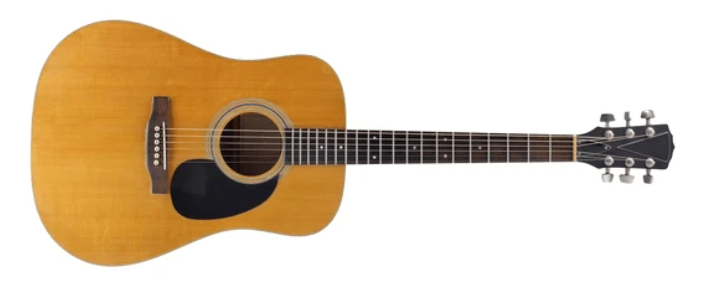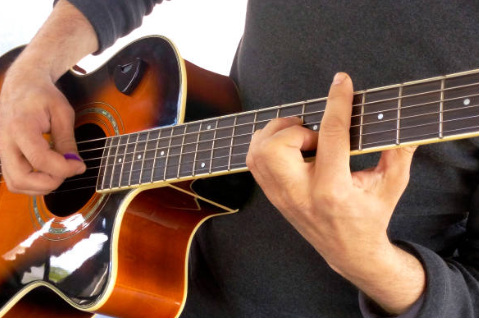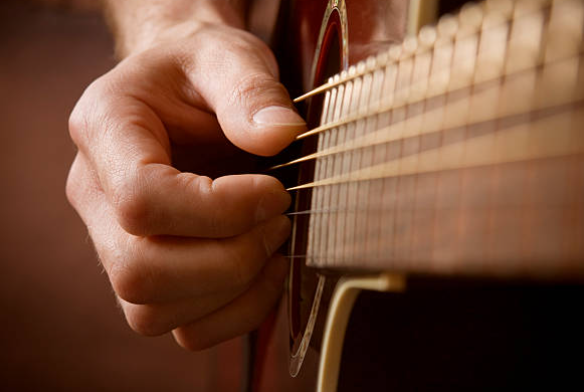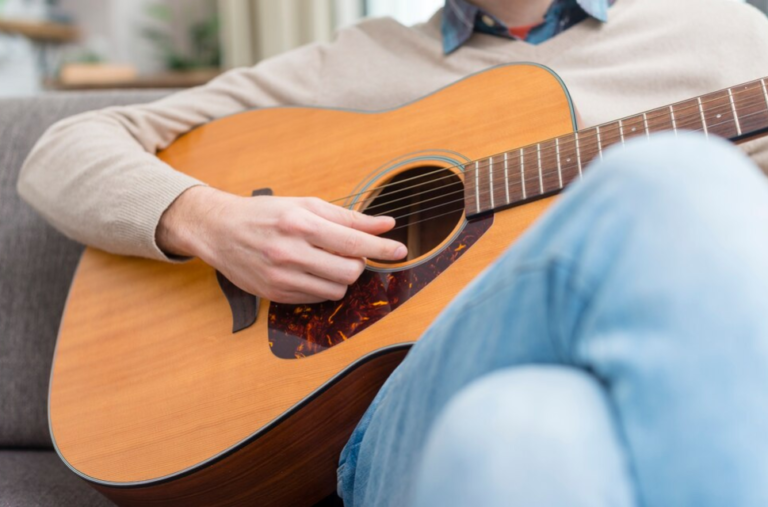Learn To Indentify The 6 Parts Of The Guitar – Easy

Parts of a guitar are essential to know, whether you’re picking up a guitar for the first time or just looking to deepen your understanding because each component plays a crucial role in creating the sounds we love, and getting familiar with them will help you communicate better when learning, playing, or even troubleshooting your instrument. Let’s dive into the anatomy of a guitar and break down its parts!
1. Headstock
The first part of the guitar is the headstock is located at the top of the guitar and is home to the tuning pegs. It’s where the strings are anchored and adjusted to change the pitch of each string.
Key Components
- Tuning Pegs (or Machine Heads): These pegs adjust the tension of the strings, allowing you to tune the guitar. Turning the pegs tightens or loosens the strings, changing their pitch.
- Nut: Found at the junction where the headstock meets the neck, the nut guides the strings from the tuning pegs down to the fretboard. It keeps the strings properly spaced and slightly raised above the fretboard.
2. Neck and Fretboard
The next part of the guitar is the neck. Is the slender part of the guitar that connects the headstock to the body. The fretboard, often made of wood like rosewood or maple, is mounted on the neck and houses the frets.
Key Components
- Frets: These metal strips run perpendicular to the strings and are crucial for determining pitch. Pressing a string against a fret shortens the string’s length, raising its pitch to produce different notes.
- Fret Markers (Inlays): Dots or other designs embedded in the fretboard help you navigate the neck quickly. Typically found on the 3rd, 5th, 7th, 9th, and 12th frets, they act as visual guides.
- Truss Rod: A metal rod inside the neck that helps maintain its stability and adjust its curvature. It’s adjustable and essential for setting the guitar’s action (string height).
3. Body
The third part is the guitar’s body where the sound is amplified, either acoustically or electrically. It can vary greatly in size, shape, and design, influencing the guitar’s tone and playability.
Key Components (Acoustic Guitar):
- Sound Hole: Found in the middle of an acoustic guitar’s body, this hole allows sound to resonate and project outwards, amplifying the natural sound of the strings.
- Bridge: Located on the body, the bridge anchors the strings at the opposite end of the tuning pegs. It transfers the strings’ vibrations into the body, playing a significant role in sound production.
- Saddle: The saddle sits on the bridge and helps maintain string height and spacing. It also affects intonation, ensuring the guitar stays in tune across the fretboard.
Key Components (Electric Guitar):
- Pickups: These are magnets wrapped in coils of wire that “pick up” the strings’ vibrations and convert them into electrical signals. The type and positioning of pickups (single-coil, humbucker, etc.) greatly affect the tone.
- Control Knobs: Typically found near the bridge, these knobs adjust volume and tone. They allow you to fine-tune your sound directly from the guitar.
- Pickup Selector Switch: This switch allows you to choose which pickup(s) to use, giving you different tonal options.
4. Strings
The next part is the strings. A standard guitar has six strings, each tuned to a specific note (E, A, D, G, B, and E from lowest to highest). The strings are the primary source of sound, vibrating when plucked or strummed.
Key Considerations
- Gauge: The thickness of the strings affects tone and playability. Thicker strings produce a fuller sound but can be harder to play, while thinner strings are easier to bend and play, especially for beginners.
- Material: Strings can be made from various materials like nickel, steel, or nylon, each offering a distinct sound and feel.
5. Pickguard (Optional)
The pickguard is a piece of plastic or other material placed below the sound hole or pickups. It protects the guitar’s finish from being scratched by picks during playing.
6. Strap Buttons
These are small metal posts on the body where a guitar strap is attached. Strap buttons are crucial for playing while standing up.
Final Thoughts
Understanding these parts not only helps you play better but also equips you with the knowledge to maintain and care for your guitar. Whether acoustic or electric, each component plays its part in creating the magic of music. So next time you pick up your guitar, take a moment to appreciate the craftsmanship that goes into every strum!
Interested in taking your guitar skills to the next level? Click the below and book a free lesson with us! We’re committed to helping you express yourself freely on the guitar without endless scales and theory. Happy playing!
Author: Daniel Powers Jr, the founder of Real Brave™, serves as the chief inspiration to thousands of students in the Real Brave music instruction program. He’s also the visionary behind PracticePad™, an online platform for live one-on-one online music lessons, lesson tracking, and scheduling. Beyond his entrepreneurial pursuits, Daniel leads a non-profit organization that provides formerly homeless children with access to music education, making a profound impact on their lives. His unwavering dedication to music, innovation, and education continues to inspire individuals to reach their fullest potential while creating positive change in communities. Follow Real Brave on all the socials:
youtube.com/@realbraveinc
twitter.com/realbraveinc
https://www.tiktok.com/@realbraveinc
instagram.com/realbraveaudio
facebook.com/realbraveinc






